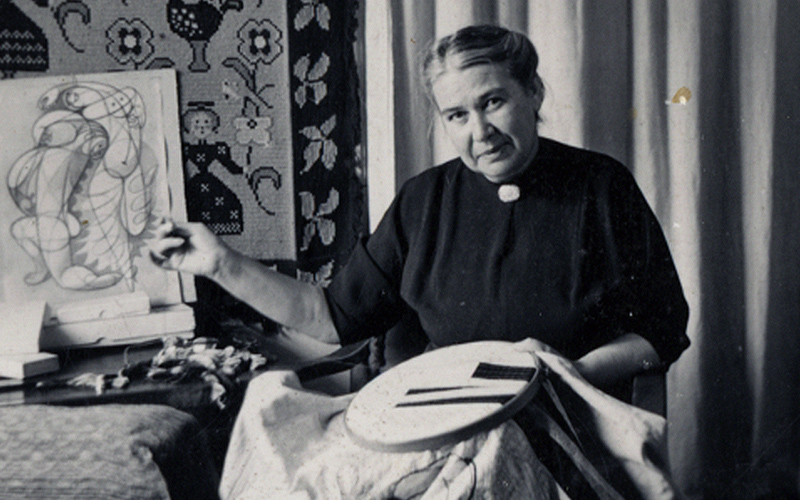Conversations About Sarah Affonso
Event Slider
Date
- / Cancelled / Sold out
Location
Atrium Gulbenkian Art LibraryA range of specialists will come together at this meeting to discuss the life and work of Sarah Affonso, looking at various thematic areas addressed by two simultaneous exhibitions: from the artists’ portraits, illustration, embroidery, textiles and ceramics, to her consideration of popular culture, in particular the emblematic region of the Minho, and the creative philosophy that she developed into a pedagogy focussed on the dissemination of feminine education, as well as her special relationship with plants, the theme of her first and last works, which she used to decorate and maintain her house.
This event will take place in the National Museum of Contemporary Art — Museu do Chiado (in the morning) and the Calouste Gulbenkian Museum (in the afternoon).
PROGRAMME
Calouste Gulbenkian Museum
Presentation
Sarah, Raquel, Tagarro, Nobre and others. Artistic practices and Portugal’s future
Vasco Rosa
The suspension — or drift — of Sarah Affonso’s artistic career was not unique in 1920s and 30s Portugal due to the limitations of the art market and the immense difficulty experienced by female artists in attaining status and visibility, even among their peers. By exploring several cases of visual artists who, like her, have been underestimated or overlooked by art critics and historians, we seek to understand these obstacles and the harmful effect they had on the recognition — and appreciation — of the artists’ unique styles, right up until the present day.
Vasco Rosa was born in Lisbon in 1958. He is an editor, independent researcher and journalist, who has focused particularly on Portuguese art and literature from the 1920s to the 1940s. He has written five books about Raul Brandão and co-authored a volume about Bernardo Marques. He has been a regular writer for Observador since June 2014.
Modernisms and the celebration of popular art
Vera Marques Alves
As Ana Vasconcelos notes in the catalogue for the exhibition Sarah Affonso e a Arte Popular do Minho (2019) [Sarah Affonso and the Popular Art of the Minho], at the time when the Portuguese artist was painting Estampa Popular [Popular Illustration], evoking the imagery of Barcelos’ clay figures, the Secretariat of National Propaganda (SPN), overseen by António Ferro, was offering copies of the very same figures to visitors to the Portuguese Pavilion at the 1937 International Exhibition of Paris.
It would be an error to point to a direct, immediate relationship between the folklorist campaign led by Ferro (which featured exhibitions of popular art as a centrepiece) and the visual creations produced by Sarah Affonso in the 1930s. Yet it would be equally incorrect to reject any connection between the two. In order to understand the approaches taken to Portuguese popular art by Ferro and Sarah Affonso in the 1930s and observe the confluences between them, we must move beyond national borders and return to the 1920s to consider the international context in particular, in which ideas circulated widely between modernist intellectuals and artists from diverse backgrounds – including the two Portuguese figures –, as well as the way in which the affirmation of the modern often merged with apology for popular culture and national identity.
Vera Marques Alves is an anthropologist and researcher at the Centro em Rede de Investigação em Antropologia (CRIA). She has conducted research into nationalist uses of ‘Portuguese popular art’ during the Estado Novo, and continues to investigate the construction of this category of objects in modernism. She has collaborated on the collective publications Vozes do povo. A folclorização em Portugal (2003), Enciclopédia da música em Portugal no século XX (2010) and Como se faz um Povo (2010). She is the author of Arte popular e nação no Estado Novo. A política folclorista do Secretariado da Propaganda Nacional (Imprensa de Ciências Socais (2013).
Which Minho did Sarah Affonso adopt?
João Alpuim Botelho
A focus on the Minho, which influenced the artist, and the way in which its image was constructed from the 19th century to the Estado Novo.
João Alpuim Botelho is a museologist. He has been the director of the Museu Bordalo Pinheiro (EGEAC) since 2014 and also worked as the director of the Museu do Traje de Viana do Castelo (1999-2009). He is co-author, together with Benjamim Pereira and António Medeiros, of Uma imagem da nação: traje à vianesa, published by Viana do Castelo Municipal Council (2009).
Watch live streaming.
